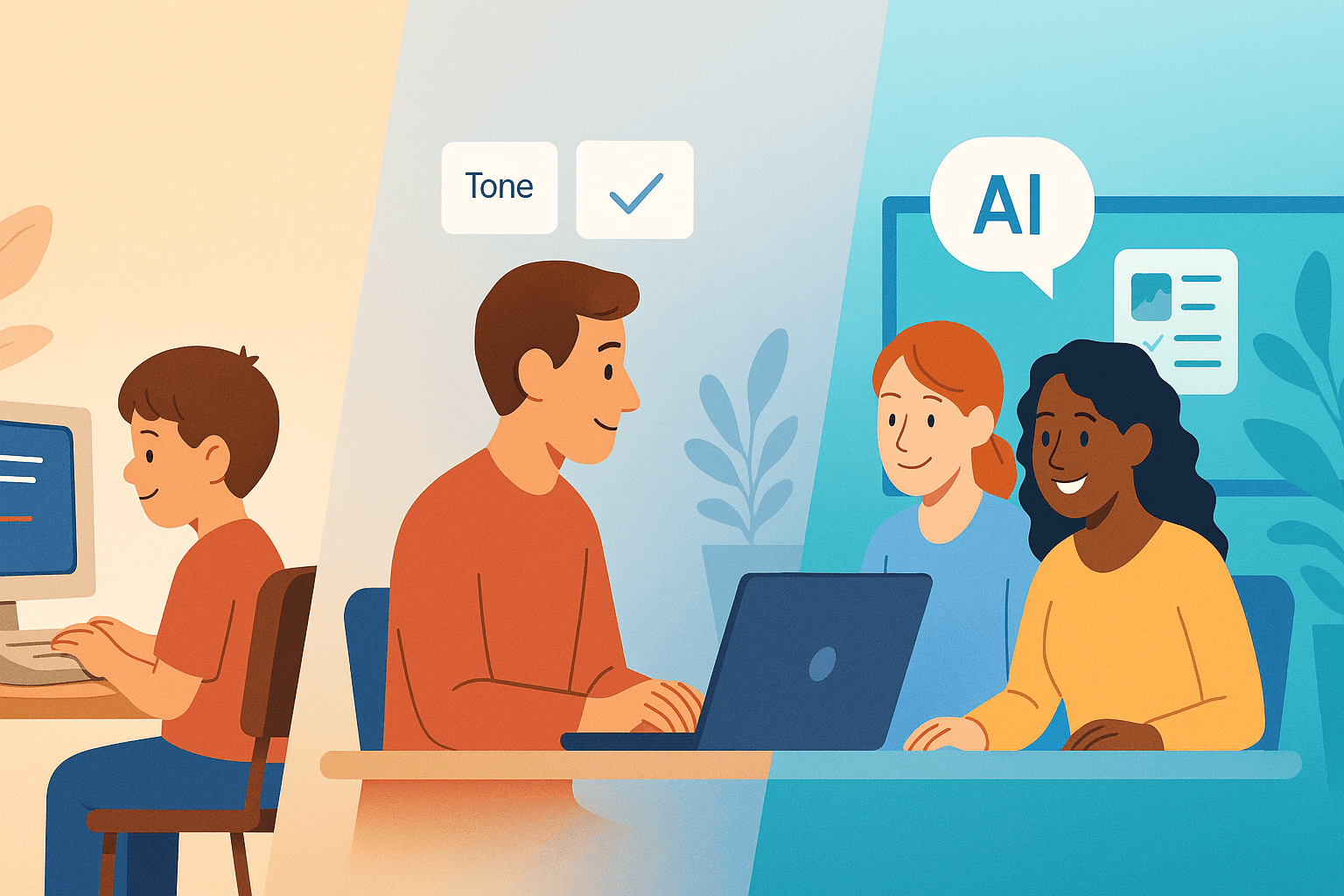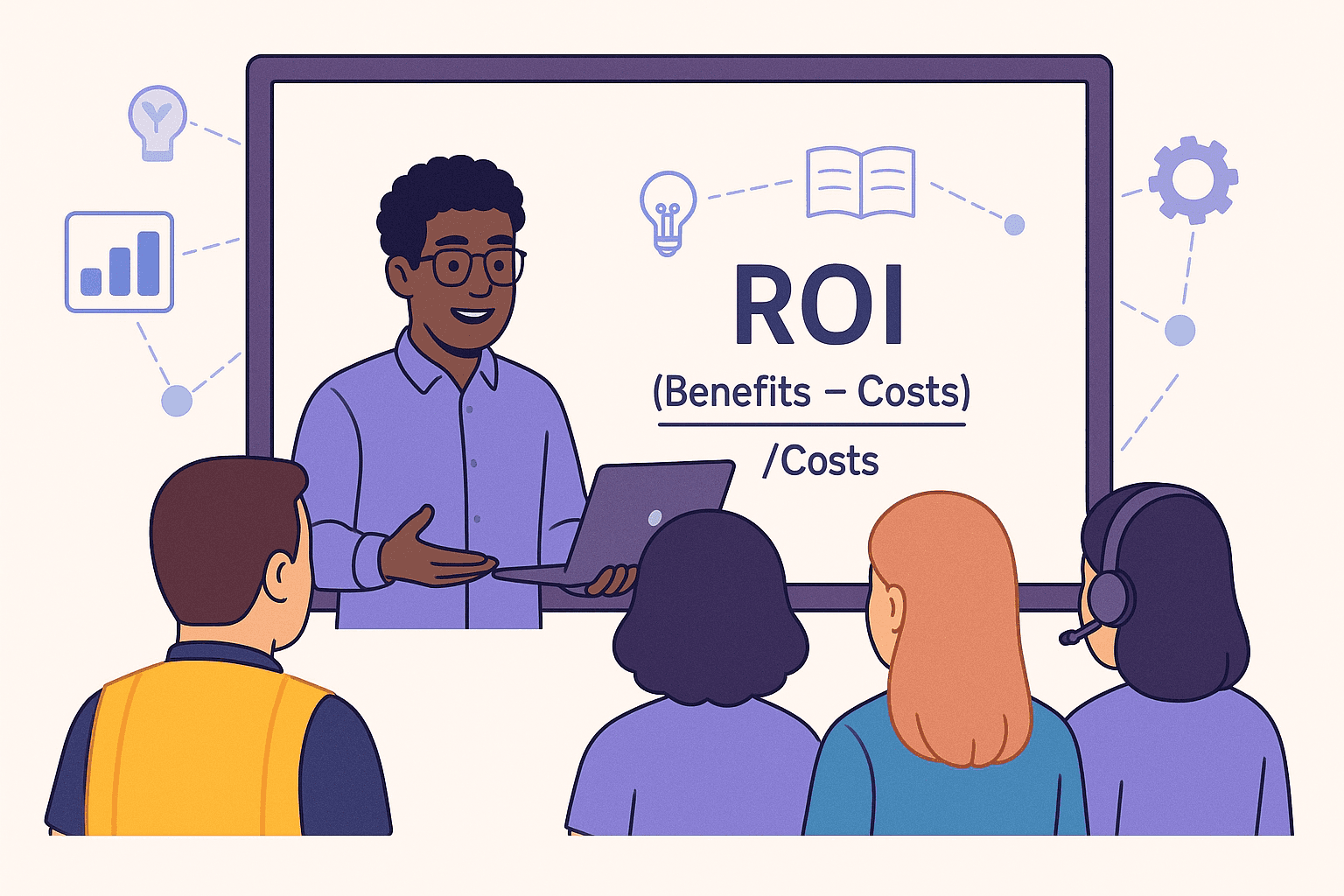3 min
23 abr 2025
¿Cuál es la diferencia y cómo decides cuál usar?
Lara Cobing

El mundo del aprendizaje en el lugar de trabajo está evolucionando rápidamente. Los Sistemas de Gestión del Aprendizaje (LMS) han sido durante mucho tiempo la base de la capacitación corporativa, asegurando el cumplimiento y la entrega estructurada de cursos. En los últimos años, han surgido las Plataformas de Experiencia de Aprendizaje (LXP) como una alternativa, ofreciendo viajes de aprendizaje más impulsados por el aprendiz, potenciados por IA y personalizados.
Para los profesionales del aprendizaje, los líderes empresariales y los equipos de recursos humanos, la decisión entre un LMS y un LXP es crítica. Cada uno sirve a un propósito diferente, pero ¿deben las organizaciones elegir uno sobre el otro? ¿O hay una alternativa más eficiente y potenciadas por IA?
LMS vs. LXP: Comprendiendo las Principales Diferencias
¿Qué es un LMS?
Un Sistema de Gestión del Aprendizaje (LMS) es una plataforma impulsada por administradores diseñada para gestionar, rastrear y entregar contenido de aprendizaje estructurado.
Las organizaciones utilizan plataformas LMS para:
Capacitación en cumplimiento y regulaciones (por ejemplo, capacitación OSHA, HIPAA o GDPR)
Incorporar nuevos empleados con materiales estandarizados
Certificaciones y cursos obligatorios
Rastrear tasas de finalización y puntuaciones de evaluación
Gestionar horarios de capacitación y asignaciones
Proporcionar evaluaciones y exámenes para medir la retención del aprendizaje
Las plataformas LMS se utilizan ampliamente en industrias donde el cumplimiento y la responsabilidad son cruciales, como en la salud, las finanzas y la manufactura. Ayudan a las organizaciones a asegurar que los empleados completen la capacitación requerida y cumplan con los estándares regulatorios. Sin embargo, aunque las plataformas LMS proporcionan estructura, a menudo carecen de adaptabilidad y características de compromiso, lo que lleva a una baja motivación del aprendiz con el tiempo.
Por ejemplo, SAP Litmos es un LMS ampliamente adoptado que ayuda a las organizaciones a garantizar el cumplimiento rastreando la finalización de capacitación obligatoria. De manera similar, Cornerstone OnDemand se integra con sistemas de recursos humanos para proporcionar capacitación corporativa estructurada.
¿Qué es un LXP?
Una Plataforma de Experiencia de Aprendizaje (LXP) adopta un enfoque impulsado por el aprendiz, permitiendo a los individuos explorar y descubrir contenido de aprendizaje basado en sus intereses y roles laborales.
Los LXPs proporcionan:
Recomendaciones de contenido impulsadas por IA basadas en el comportamiento del usuario
Aprendizaje autodirigido y abierto en lugar de cursos asignados
Integración con bibliotecas de contenido externas (por ejemplo, LinkedIn Learning, Coursera)
Elementos de aprendizaje social, como foros de discusión y compartir contenido entre pares
Elementos de gamificación e interactividad para mejorar el compromiso
Oportunidades de microaprendizaje que permiten a los aprendices consumir contenido en sesiones cortas y enfocadas
Los LXPs son particularmente efectivos para organizaciones enfocadas en aprendizaje continuo, desarrollo profesional y mejora de habilidades de los empleados. Empoderan a los empleados para que tomen el control de sus propios caminos de aprendizaje, haciendo que la capacitación sea más atractiva y relevante.
Un gran ejemplo de un LXP es Degreed, que permite a los empleados curar sus propias experiencias de aprendizaje combinando cursos proporcionados por la empresa con contenido externo de plataformas como LinkedIn Learning. Otro es 360Learning, que se centra en el aprendizaje colaborativo al habilitar el intercambio de conocimientos entre pares.
Característica | LMS | LXP |
¿Quién controla el aprendizaje? | Administradores/formadores | Aprendices |
Creación de contenido | Cursos preconstruidos | Recomendado por IA y curado |
Propósito | Cumplimiento, capacitación estructurada | Aprendizaje continuo, mejora de habilidades |
Personalización | Limitada | Impulsada por IA, adaptativa |
Compromiso del usuario | Módulos estructurados | Social, interactivo, colaborativo |
Analíticas | Rastreo de finalización y cumplimiento | Información de compromiso y rutas de aprendizaje |
Interactividad | Cuestionarios, evaluaciones | Gamificación, compartir socialmente |
Formato de aprendizaje | Capacitación formal, programada | Aprendizaje informal, bajo demanda |
Cada sistema tiene sus fortalezas, pero las empresas a menudo luchan por equilibrar la naturaleza estructurada de un LMS con la personalización de un LXP.
El Desafío: Equilibrando la Estructura con la Flexibilidad
La mayoría de las organizaciones necesitan una combinación de estructura y personalización en su estrategia de aprendizaje para asegurar tanto la capacitación impulsada por el cumplimiento como el desarrollo continuo de habilidades. Sin embargo, usar tanto un LMS como un LXP puede crear desafíos logísticos, financieros y operativos:
Problemas de integración: Las plataformas LMS y LXP pueden no funcionar juntas sin problemas, requiriendo API personalizadas, middleware o soluciones manuales.
Costos incrementados: Invertir en dos sistemas lleva a tarifas de licencia más altas, carga administrativa y costos de soporte técnico.
Redundancia de contenido: El contenido almacenado en ambas plataformas puede superponerse, llevando a duplicación, problemas de control de versiones y experiencias de capacitación inconsistentes.
Falta de adopción: Los empleados pueden resistirse a usar múltiples plataformas, resultando en bajo compromiso y subutilización de recursos.
Desafíos de reporte: Las organizaciones luchan por agregar el progreso y los datos de rendimiento de los aprendices cuando múltiples sistemas almacenan analíticas por separado.
Preocupaciones de escalabilidad: A medida que las empresas crecen, gestionar sistemas separados puede ralentizar el despliegue y crear cuellos de botella en la entrega de capacitación.
La Necesidad de una Solución Más Inteligente
En lugar de invertir en múltiples plataformas desconectadas, las organizaciones deben buscar ecosistemas de aprendizaje unificados potenciados por IA que proporcionen capacitación estructurada en cumplimiento y oportunidades flexibles de mejora de habilidades—sin complejidad innecesaria.
Dada estas desafíos, las organizaciones necesitan un enfoque más inteligente, impulsado por IA que simplifique la gestión del aprendizaje sin compromisos. En lugar de malabarear múltiples plataformas, las empresas deberían buscar una solución unificada que mezcle sin problemas estructura, compromiso y adaptabilidad.
Entonces, ¿cómo pueden las empresas integrar efectivamente el aprendizaje estructurado y las experiencias personalizadas mientras minimizan costos y esfuerzos?
Mindsmith: Integrándose con LMS y LXP con Dynamic SCORM
Mindsmith inventó un nuevo estándar de eLearning llamado Dynamic SCORM. Dynamic SCORM facilita la integración con cualquier sistema de aprendizaje a través de la infraestructura SCORM mientras proporciona características dinámicas como lecciones de actualización automática, gestión de idioma fácil y análisis de compromiso con el aprendizaje.
Preparando el Futuro del Aprendizaje: Impulsado por IA, Ágil y Atractivo
El rápido avance de la IA está remodelando el aprendizaje corporativo. En los próximos cinco años, las plataformas impulsadas por IA no solo mejorarán la personalización, sino que también predecirán brechas de habilidades, recomendarán rutas de aprendizaje basadas en tendencias de la fuerza laboral y automatizarán la adaptación de la capacitación según métricas de rendimiento en tiempo real. Este cambio permitirá a las organizaciones anticipar necesidades de capacitación futuras en lugar de reaccionar a ellas.
A medida que la IA continúa evolucionando, los sistemas de aprendizaje proporcionarán aún más analíticas predictivas, rutas de cursos hiperpersonalizadas y aprendizaje adaptativo en tiempo real, asegurando que los empleados se mantengan a la vanguardia en una fuerza laboral que cambia rápidamente. Las organizaciones que adopten el aprendizaje impulsado por IA hoy estarán mejor posicionadas para mantener una ventaja competitiva en el futuro.
Pensamiento Final: Elegir Más Inteligente, No Más
En lugar de debatir LMS vs. LXP, las organizaciones deberían enfocarse en adoptar una solución de aprendizaje que integre sin problemas estructura con adaptabilidad. El enfoque correcto asegura el cumplimiento, fomenta el aprendizaje continuo y mantiene a los empleados comprometidos sin la carga de gestionar múltiples plataformas. Mindsmith proporciona una solución de aprendizaje moderna, impulsada por IA que agiliza los procesos de capacitación y asegura que el aprendizaje sea tanto atractivo como efectivo.



